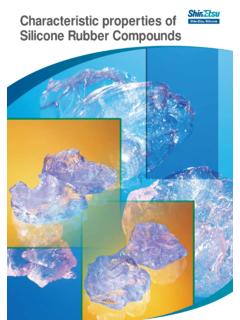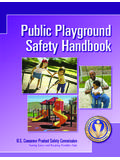Transcription of 4.12 Manufacture of Rubber Products
1 Manufacture of Rubber Products General Process Description1 Many of the Rubber manufacturing facilities in the United States produce pneumatic tires for automobile, trucks, airplanes and farm machinery. However, many Rubber manufacturing facilities produce other engineered Rubber Products . The processes involved in these industries are very similar. Differences basically consist of the raw Rubber material (natural or synthetic) used, the chemical additives, and the type of curing employed. The following is a description of a generic Rubber manufacturing facility applicable to both tire and other manufactured Rubber Products , except where noted. The manufacturing of Rubber Products involves six principal processing steps (mixing, milling, extrusion, calendering, curing, and grinding), with ancillary steps in between.
2 Initially, the raw Rubber (natural or synthetic) is mixed with several additives which are chosen based upon the desired properties of the final product. The mixed Rubber is often milled and transferred to an extruder where it can be combined with other rubbers. Many Rubber Products contain synthetic fabric or fibers for strengthening purposes. These fibers are typically coated with mixed Rubber using a calender. The extruded Rubber and Rubber coated materials are then assembled into a final shape and cured. Among the steps in the tire assembly process, described in more detail below, are bead building; cementing and marking; cutting and cooling; tire building; and green tire spraying. It is during the curing process that the Rubber vulcanizes (crosslinks), producing the characteristic properties of finished Rubber .
3 Once the final product is cured, it is often ground to remove rough surfaces and/or to achieve symmetry. Mixing consists of taking the raw Rubber and mixing it with several chemical additives. These additives consist of accelerators (to initiate the vulcanization process), zinc oxides (to assist in accelerating vulcanization), retarders (to prevent premature vulcanization), antioxidants (to prevents aging), softeners (to facilitate processing of the Rubber ), carbon black or other fillers (to serve as reinforcing / strengthening agents), and inorganic or organic sulfur compounds (to serve as vulcanizing agents). Mixing typically is performed in an internal batch mixer. The internal mixer contains two rotors which shear the Rubber mix against the wall of the vessel.
4 Internal mixing is performed at elevated temperatures up to approximately 330oF. Once mixed, the Rubber is discharged from the mixer and processed into slab Rubber or pellets. Rubber mixing typically occurs in two or more stages wherein the Rubber is returned to the mixer and re-mixed with additional chemicals. The initial stage results in non-productive compounds, and the final stage results in productive compounds. It should also be noted that various Rubber compounds produced at a particular facility can be exported to other facilities for use there. Non-productive compounds consist of the raw Rubber , process oils, reinforcing materials such as carbon black and / or silica and the antioxidant / antiozonant protection system.
5 These materials are mixed at temperatures around 330oF. The final, productive, stage involves mixing the Rubber from the last non-productive stage with the activators, accelerators and sulfur curing agents. This stage is mixed at a lower temperature (around 230oF) because the Rubber compound will now scorch and cure at elevated temperatures. Evaporation Loss Sources 11/08 The majority of Rubber Products produced in the United States are composed of one or more of 23 generic Rubber compounds shown in Table Emissions factors were derived from the specific compound recipes shown in Table Emissions from manufacturing aids such as solvents and adhesives ARE NOT included in these emission factors.
6 Table Index of Rubber Compounds Compound #1: Tire Inner Liner (BrIIR/NR) Compound #2: Tire Ply Coat (Natural Rubber / Synthetic Rubber ) Compound #3: Tire Belt Coat (Natural Rubber ) Compound #4: Tire Base/Sidewall (Natural Rubber / Polybutadiene Rubber ) Compound #5: Tire Apex (Natural Rubber ) Compound #6: Tire Tread (Styrene Butadiene Rubber / Polybutadiene Rubber ) Compound #7: Tire Bladder (Butyl Rubber ) Compound #8: EPDM 1 (EPDM Sulfur Cure) Compound #9: EPDM 2 (Peroxide Cure) Compound #10: EPDM 3 (Non-Black EPDM Sulfur Cure) Compound #11: CRW (Polychloroprene W Type) Compound #12: CRG (Polychloroprene G Type) Compound #13: Paracryl OZO (NBR/PVC) Compound #14: Paracryl BLT (NBR) Compound #15: Hypalon (CSM) Compound #16: Fluoroelastomer (FKM) Compound #17: AEM (Vamac) Compound #18: Hydrogenated Nitrile (HNBR) Compound #19: Silicone (VMQ) Compound #20: Acrylate Rubber (ACM) Compound #21: Chlorinated Polyethylene (CPE) Compound #22: Emulsion SBR (SBR 1502) Compound #23.
7 Epichlorohydrin (ECO) EMISSION FACTORS 11/08 Table Rubber Compound Recipesa Compound #1: Tire Inner Liner (BrIIR/NR) Recipe: Brominated IIR X-2 SMR 20 Natural Rubber GPF Black Stearic Acid Paraffinic Medium Process Oil Unreactive Phenol Formaldehyde Type Resin (Arofene 8318, SP1068) Zinc Oxide Sulfur.
8 50 MBTS Number of Passes/Temperature: 1 (NP Temperature: 320 F; Chlorobutyl or 290 F Bromobutyl) 2 (P) Temperature: 220 F Compound #2: Tire Ply Coat (Natural Rubber / Synthetic Rubber ) Recipe: 50472 Natural Rubber SMR-GP Natural Rubber Duradene 707 N330 Sundex 790 Flectol H Santoflex IP Sunproof Super Wax Zinc Oxide Stearic Acid Sulfur CBS.
9 80 Number of Passes / Temperature: 1 (NP) Temperature: 330 F 2 (P) Temperature: 220 F EMISSION FACTORS 11/08 Table (cont.) Rubber Compound Recipes Compound #3: Tire Belt Coat (Natural Rubber ) Recipe: #1 RSS Natural Rubber HAF Black (N330) Aromatic Oil N-(1,3 dimethylbutyl)-N-phenyl-P-phenylene diamine (Santoflex 13) Zinc Oxide Stearic Acid n-tertiary-butyl-2-benzothiazole disulfide (Vanax NS).
10 80 Sulfur Cobalt Neodecanate ( cobalt) Number of Passes / Temperatures: 1 (NP) Temperature: 330 F; add 1/2 black, add 1/2 oil 2 (NP) Temperature: 330 F, add remainder of black and oil 3 (remill) Temperature: 300 F 4 (P) Temperature: 220 F Compound #4: Tire Base / Sidewall (Natural Rubber / Polybutadiene Rubber ) Non-Productive Recipe: NR-SMR-5 CV Taktene 1220 N330 Carbon Black Zinc Oxide Stearic Acid Agerite Resin D Vulkanox 4020 Vanwax H Special Flexon 580 Oil Productive Recipe.
















